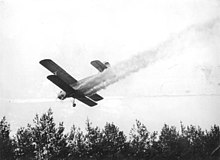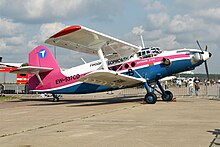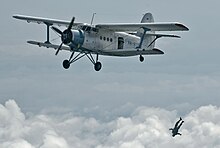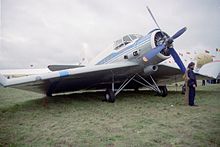Antonov An-2
| Antonov An-2 | |
|---|---|
 Antonov An-2 of the Awialessoochrana |
|
| Type: | STOL - multipurpose aircraft |
| Design country: | |
| Manufacturer: | |
| First flight: |
August 31, 1947 |
| Production time: |
In series production since 1947 |
| Number of pieces: |
approx. 18,000 |


The Antonov An-2 ( NATO reporting name : Colt ) is a STOL - multi-purpose aircraft with over 18 m span the largest in use single-engine biplane in the world. The An-2 was developed in the USSR after the Second World War and is used in large numbers for both civil and military purposes. With its large wing area , the An-2 is designed for slow flight and extremely short take-off and landing taxiways; the landing gear allows take-off and landing on unpaved surfaces.
development
The An-2 was commissioned by the Soviet Ministry of Agriculture and Forestry. It was the first motorized design built in large numbers by the designer Oleg Konstantinowitsch Antonow , who until then had been involved in the construction of gliders and fighter planes and had just opened his own design office (OKB) at the time .
Although the time of the double-decker was long gone, Antonov realized that the concept of the double-decker offered a number of advantages, especially for the intended purpose. The higher air resistance and the mutual aerodynamic influence of the individual wings were meaningless at the planned operational speeds. A small span, on the other hand, has advantages when maneuvering on the ground, shelters and hangars could be smaller. The large wing area generated a lot of lift even at low speeds, which reduced take-off and landing speeds and consequently shortened the necessary take-off and landing distances. The machine was able to operate from small places, which made it the perfect aircraft for short distances to remote settlements in the vast expanse of the Soviet Union.
The prototype of the An-2 flew for the first time with a seven - cylinder ASch-21 radial engine on August 31, 1947. The pilot was N. P. Wolodin. A second prototype received the Schwezow ASch-62 engine , which was retained for production. Series production began in October 1948 in the aircraft factory No. 473 in Kiev-Swiatoschino. It ran until around 1959 and comprised 5450 machines. From 1960, production was relocated from the Soviet Union to Poland , where another 11,950 units were built at PZL in Mielec under the name WSK An-2 . The An-2 are prepared in Poland to the GRP coverings for the two mounted under the fuselage antennas of the radio altimeter recognizable RW-UM and to the circular inlet openings for the ventilation system below the upper wing. From the 60th series onwards, the span of the horizontal stabilizer was increased from 6.6 m to 7.2 m. The An-2 was equipped with different propellers during its construction period. In the beginning these were crescent-shaped W-509A with a diameter of 3.60 m, then wooden propellers and later metal propellers of the AW-2 type with 3.35 m were used.
In the People's Republic of China , license production of the An-2 began in 1957 as the Fongsu-2 or Yunshuji-5 (Y-5). A total of 938 aircraft were produced in Nanchang until 1968 and Harbin , and from 1970 also in Shijiazhuang . They are equipped with an ASch-62IR license motor HS-5. North Korea bought 160 pieces.
Around 18,000 An-2s had been built by 1992. The An-2 was delivered to all Warsaw Pact states , including the GDR , which used 74 units at GST , NVA and Interflug . Other users are / were Afghanistan, Egypt, France, Greece, India, Cuba, Mali, Mongolia, Nepal, the Netherlands, Sudan and Tunisia.
As early as the 1970s, the Antonov An-3 was an An-2 with a turboprop drive.
Todays situation
Numerous copies of the An-2 are still in airworthy condition today, are generally considered safe, carry out individual or sightseeing flights or are used for spray flights . The An-2 is also still in use in regular service between small squares, until 2013 a machine flew between Sylt and Wyk auf Föhr .
Since the An-2 has often reached the limit of its service life, but the successor states of the Soviet Union , especially Russia, are urgently dependent on small feeder aircraft to cover the infrastructure, several modernizations are in development.
The Siberian Scientific Research Institute for Aviation "SA Tschaplygin" (SibNIA) in Novosibirsk tested an An-2 called TWS-2MS from February 2012, in which the radial engine was replaced by a Honeywell TPE331-12UHR turboprop engine , which improves its performance to a five-blade propeller HC-B5MP from Hartzell. According to the pilots, in addition to improved performance, the control of the aircraft was also made easier. The main motivation for this retrofit is savings in operating costs. Quite a few An-2s have been converted in this way since 2013. As a further development, the TWS-2DT emerged , from which two technology carriers were built; On the one hand, a design as a pure shoulder wing with a trapezoidal wing made of carbon fiber-reinforced plastic , and on the other hand, a lower wing connected to the upper wing like a winglet without bracing, the testing of which was completed in 2017. The first flight of the SibNIA TWS-2DTS with a newly designed fuselage took place on July 10, 2018.
The Ukrainian An-2 modernization is called An-2-100 and is equipped with an MS-14 propeller turbine from Motor Sitsch . It flew for the first time on July 10, 2013 and is in direct competition with the Russian version.
In September 2019 it was announced that the SibNIA TWS-2DTS would not be the replacement of the An-2 aircraft type, rather the Ministry of Industry and Trade asked the state procurement portal for research and development to design a monoplane. Avoiding foreign components may have played a role. This delayed the replacement of the remaining An-2 foreseeably.
technical structure
The hull of the An-2 is made of all-metal half - shell construction and has a rectangular cross-section in the area of the cabin, which tapers ovally towards the bow and stern. The elevators of the braced normal tail unit are covered with fabric.
Due to the smaller wingspan of the lower wings of 14.24 m, the An-2 is also known as a one-and-a-half-decker. The wings have two spars and are covered with metal from the leading edge to the first spar, otherwise covered with linen . They are waterproof impregnated with a coat of paint and form a structural bond with two vertical I-struts and crosswise double bracing. Both wings have electrically operated landing flaps and automatic slats as lift aids, as well as ailerons that can be lowered by 20 °, which enable the An-2 to take off and land very short distances of only around 150 to 180 m.
The non-retractable, robust broad-gauge chassis enables use on unpaved slopes. The machine can optionally be equipped with floats or skids.
The 1,000 HP (735 kW ) 9-cylinder radial engine of the type ASch-62 IR with a four-blade adjustable propeller of the type AW-2 consumes around 180 liters of fuel and two to three liters of lubricating oil per hour. The fuel supply is a maximum of 1200 liters and is carried in a total of six containers in the upper wings. The engine is started with the help of a flywheel, which can usually be brought to the required speed electrically, but if necessary also manually with a crank, and which is then connected to the crankshaft via a reduction gear.
Versions

| designation | features |
|---|---|
| SCh-1 | Original designation of the prototype and the first batch with a Schwezow ASch-21 engine with 559 kW (760 PS) and a sickle-shaped propeller. The name stands for Selsko-chosjaistwennij samoljot, agricultural aircraft. The SCh-1 had a 1400 liter tank and a six-point spreading system under the wings. The spread was 60 to 100 meters. The first spray tests were carried out in June 1948 by G. I. Lysenko. |
| An-2P | Multi-purpose variant for up to twelve passengers (P stands for Passaschirski), eight to ten parachutists or 1500 kg cargo. In the medical version , it can carry six stretchers and two paramedics. The version as an agricultural aircraft is called An-2S. The Polish version (An-2T) has better soundproofing and a better propeller. |
| An-2W ( An-4 ) |
Float version from 1949. The W-514-D8 propeller was able to generate negative thrust in order to shorten the braking distance after landing and to facilitate maneuvering on the water. In 1954 a small series was created. |
| An-2PP | Fire extinguishing version of the An-2W (PP stands for Protiwoposcharnij) with tanks for 1240 liters of water. At a flight speed of around 50 km / h, 630 liters could be absorbed from the water surface in seven seconds. |
| An-2Sa An-6 |
Height version for meteorological research with an additional pulpit in front of the tail unit to observe ice formation. |
| An-2M | Agricultural aircraft |
| An-2F (An-2K-NAK, An-2NRK) |
Artillery observation and aerial photography aircraft (1948) with glazed central fuselage, armament with 1–2 23 mm MK and double tail unit . Two prototypes with different propellers were tested from April 1949. No series production. |
| An-2L | Version for chemical fire fighting with glass containers under the fuselage and wings. |
| An-2T | Polish version of the multi-purpose variant. Better sound insulation and a better propeller than the An-2P. |
| An-2TP | Airplane for passenger and cargo transportation with twelve folding seats . |
| An-2TD | Freight and parachute drop aircraft for up to twelve jumpers. In the NVA , the TP and TD versions were mainly used. |
| An-2S (An-2D6, An-2PLux) |
Salon model with four upholstered seats and a table. Outwardly recognizable by the angular cabin windows. A medical version equipped with three stretchers is also called S. |
| An-2M | Polish counterpart to the An-2W. |
| An-2R | Special agricultural version with hermetically sealed cockpit and 1960 liter fertilizer container. |
| Lala-1 | Experimental version with double tail girders for research tests for the planned TL agricultural aircraft PZL M-15 Belphegor . Lala stands for "Flying Laboratory" (Polish: Latające Laboratorium). The first flight was April 26, 1972. |
| An-2E | E. Grunin project for an Ekranoplans from the 1970s based on the An-2W. |
Technical specifications
| Parameter | An-2P (WSK-PZL) | An-2K-NAK |
|---|---|---|
| use | Multipurpose aircraft | Artillery observation |
| crew | 1 | 3 |
| Passengers | Max. 12 | - |
| length | 12.74 m | 12.73 m |
| span | top: 18.18 m / bottom: 14.24 m | 18.17 m |
| Wing area | a total of 71.60 m² | 71.31 m² |
| Height (standing) | 4.13 m | |
| Empty mass | 3450 kg | 3320 kg |
| Max. Takeoff mass | 5500 kg | 5250 kg |
| Cruising speed | 190 km / h | |
| Top speed | 258 km / h (at an altitude of 1750 m) | 253 km / h |
| Landing speed | 85 km / h | |
| Service ceiling | 4400 m | 4500 m |
| Range | 1390 km (with max. Refueling, without reserves) | 4 h flight time |
| Engine | a nine- cylinder radial engine Schwezow ASch-62IR | |
| power | 1,000 PS (735 kW) | |
| Take-off run | 150 m | |
| Landing runway | 180 m | |
Incidents
- On December 10, 1960, an Aeroflot Antonov An-2T ( aircraft registration number Cyrillic СССР-33181; transcribed SSSR-33181), with which a flight from Semipalatinsk to Abai was carried out, had an accident . The machine took off without a valid meteorological report and encountered very difficult weather conditions along the route. When a U-turn for the return to Semipalatinsk was flown 45 kilometers from the departure airport, several passengers moved to the rear fuselage area to the on-board toilet. This resulted in a shift in the center of gravity, which led to a stall and ultimately to the machine crashing. All 12 occupants were killed (see also Aeroflot flight 11 ) .
Others
The nicknames of the An-2 in the NVA were "Anna", "Aunt Anna" or "Box dragons". The An-2 is the only aircraft of the GDR air force that was in service from its establishment in 1956 until its dissolution in 1990. The large engine and its robustness have earned it the nickname “Tractor of the Air”.
In agricultural aviation in the Soviet Union, the aircraft was sometimes nicknamed "Kukurusnik" ( Russian: "Кукурузник", from "Кукуруза" - corn ). This reflects the massive use of the aircraft in the Soviet Union in the 1960s in the implementation of Khrushchev's agricultural plans, which provided for the extensive cultivation of corn with intensive use of agricultural technology.
In the docu-soap Steel Buddies - Steel Hard Shops (Seasons 2 and 3) Michael Manousakis equips his An-2 with additional tanks and an oil refill device, which enables him to fly the aircraft non-stop from Germany to Mallorca in 8 hours and later - with stopovers in Wick (Scotland), Reykjavík (Iceland), Narsarsuaq (Greenland) and Sept-Îles (Canada) - can be transferred to the USA.
literature
- Państwowe Zakłady Lotnicze (PZL) Mielec (Ed.): Flight Manual for An-2 airplane with ASz-62IR engine . Versions: An-2R Agricultural, An-2T Cargo Transport, An-2TP Passenger Transport, An-2TD Transport Parachute, An-2P Passenger. Mielec November 15, 1970 (335 pages, English, last updated in 1992, complete operating instructions with technical drawings and tables).
- Bernd Kirchhof, Jürgen Willisch: Antonow AN-2 (= the aircraft of the National People's Army ). 1st edition. Bmvd, Buchholz 2003, ISBN 3-935761-87-2 (128 pages, The use of the An-2 in the NVA with many technical details, photos and drawings).
- to versions: Flieger Revue. Military Publishing House of the GDR, issue 5/1979 p. 220 and 12/88 p. 381
- An aviation legend turns 70: Antonov An-2 multi-purpose aircraft. In: FliegerRevue No. 11/2017, pp. 44–49
Web links
- Archive of the private German-language An-2 type site at Luftfahrt-Eisenach.de ( Memento from March 12, 2013 in the Internet Archive )
- Private website of the Transport Aviation School DESSAU / Garz
- Report on a flight in the Antonov An-2 on FliegerWeb.com
Individual evidence
- ^ Detlef Billig, Manfred Meyer: Airplanes of the GDR. Type book military and civil aviation. Volume I until 1962. Friedland 2002, ISBN 3-613-02197-8 . Pp. 38-49.
- ^ In the Delayed Disaster Zone , Novaya Gazeta, April 9, 2018
- ↑ Hanse flight
- ↑ Initial tests of Honeywell TPE-331-powered An-2 completed. Flightglobal.com, August 29, 2012, accessed August 31, 2012 .
- ↑ Robert Kluge: Successor to Antonow An-2 wanted. In: Fliegerrevue No. 12/2015, pp. 20–23
- ↑ Замену Ан-2 разработает УЗГА (A replacement for the An-2 is being developed by USGA) , aviation21.ru, September 12, 2019, accessed May 5, 2020 (Russian)
- ↑ Владислав Филев: Гражданский авиапром на сегодняшний день глубоко убыточен (Vladislav Filjew: The civil aviation industry is now deeply unprofitable ) retrieved September 3, 2019 Vedomosti on May 5, 2020 (Russian).
- ↑ Ан-2 ищут новую замену (An-2 looking for a new replacement) , Kommersant, August 25, 2019, accessed May 5, 2020 (Russian)
- ↑ What will and when will the Baikal fly , aviation21.ru, September 9, 2019
- ↑ Antonow An-2 ( Memento from August 4, 2009 in the Internet Archive ) in the Airliners.de aircraft lexicon, accessed on November 23, 2010
- ↑ Państwowe Zakłady Lotnicze (PZL) Mielec (Ed.): Flight Manual for An-2 airplane with ASz-62IR engine . Mielec November 15, 1970, 4-00, pp. 40 .
- ^ Bernd Kirchhof, Jürgen Willisch: Antonow AN-2 . 1st edition. Bmvd, Buchholz 2003, ISBN 3-935761-87-2 , p. 58 f .
- ↑ Antonov An-2 "Colt". In Aircraft - The New Aviation Encyclopedia. TOPIC, Munich 1993, p. 1374.
- ^ A b Antonov An-2K-NAK . In: Fliegerrevue . No. 12 , 1988, pp. 381 .
- ^ Wilfried Copenhagen: Airplanes and helicopters of the NVA from 1956 to 1970. Brandenburgisches Verlagshaus, Berlin 1990, ISBN 3-327-00547-8 , p. 48.
- ↑ DMAX shows "Steel Buddies" special on New Years. In: dwdl.de. December 9, 2015, accessed August 2, 2020 .









